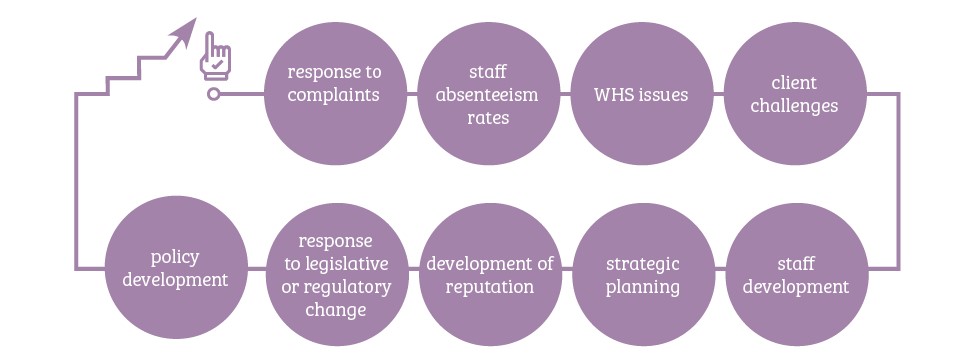It is important to stay up-to-date with new information and concepts in compliance in community services. You should seek out opportunities to develop your skills and to share your learning with others. This will help you in applying compliance developments to the continuous improvement process in your workplace.
By the end of this chapter, you will understand:
- how to build your knowledge of legal requirements and ethical issues
- how to share your knowledge with others
- how to apply your learning to the continuous improvement process.
There are a range of ways that you can build your knowledge regarding legislation and legal requirements.
It is vital that you stay up-to-date with changes to compliance requirements by building on your own skills and knowledge.
Here are some strategies you can use:
- Stay up-to-date with compliance changes by receiving and checking communications, documents and memos from regulatory bodies
- Maintain an awareness of how compliance applies to your workplace
- Ensure that compliance requirements form part of the planning process for all new projects and processes and that policies and procedures are formulated and updated accordingly
- Participate in professional development opportunities
- Seek advice (internal or external) when unsure
- Participate actively in discussions, meetings, appraisals, training and mentoring
- Report and highlight areas of concern to senior management and seek advice and guidance
| Activity 5A |
|---|
|
Professional Development Have a discussion with another person (in face or virtually) to identify your preferred ways of accessing professional development. Do you both like to learn in the same way or are there differences? How can you apply your observations about professional development to a team training situation where you are in charge of organising professional development for other workers? |
As a supervisor, there will be times when there is a necessity for you to share information which relates to compliance updates, new legislation or ethical issues. For example:
- New policies and procedures
- Changes to policies and procedures
- Legislative change
- Crisis management
- Operational planning
- Rostering
- Staffing issues
- Performance planning/review
While the need for positive and effective communication techniques and role-modelling stays the same, the delivery method and organisational requirements can differ.
You should consider various factors which will influence the way you share information, such as:

| Case Study |
|---|
| Franco leads a small work team of outreach community workers. His team have a busy weekly schedule which can be variable and unpredictable, depending on client needs and responses to crisis situations. He needs to update his team about some recent compliance changes that will affect their record keeping. He decides to develop a series of short teams meetings which he records. He prepares some slides that capture the key information visually as well as talking about the key points. Most of the team are able to attend the meeting when it is run, but two team members leave part way through to attend to urgent client needs and return to watch the rest of the meeting later. |
Delivery Methods
Delivery methods for the types of information mentioned above differ from organisation to organisation but in a sector like community services which is so heavily regulated, compliance is generally important so the delivery method can be quite formal. Some examples are explained below.
Online Training Strategy
Some organisations develop learning management systems or online training systems which contain a number of training modules (often supported by online quizzes) that staff log-in to and complete. The system logs successful completion of the module and the staff member’s supervisor may be asked to follow up with a staff member who has not completed a module or not completed it successfully by a specified date.
Professional Development Sessions
Professional Development Sessions
Newsletters
Some organisations compile changes and updates into newsletters and ask supervisors to follow up with individual staff to ensure that they have an understanding of any changes and how they might be impacted.
Bulletins
Some organisations use email bulletins with an email read-receipt. The assumption is made that if the team member has opened the email, they have read the bulletin.
Supervisor Communication
Some organisations rely on their supervisors to communicate with their teams and to ensure that new practices are adopted and that compliance information is updated and shared effectively.
Other Strategies
Other strategies include:
- No strategy: the organisation has an expectation that team members will stay abreast of changes as part of their professional obligation
- Professional association membership: some organisations sign their members up to professional associations which update members via journals, association newsletters etc.
- Variety of strategies: some organisations use a mix of many of the strategies described above
| Example |
|---|
| Cheryl has noticed that there has recently been a call for public submissions as part of a public housing review. She accesses the website and reads the information about the proposed changes. She downloads the information and shares it with her work team. They discuss the proposed changes and how they might impact clients in their service. Together they write a submission on behalf of their organisation and submit it to the review online. |
| Activity 5B |
|---|
|
Working with Children Checks Aratin has been asked by his senior manager to update his work team about recent changes to legislation relating to working with children checks. He needs to find out: |
| What the legislation was |
| How the organisation used to manage compliance with the legislation |
| What has changed in the legislation |
| What the organisation will need to do now |
| Help Aratin write some notes or prepare a slideshow about the information to share with his team. |
Continuous improvement is an essential tool for contributing to the overall success and development of the organisation. It is a way of aligning individual, team and whole of workplace success and skill development and working collectively towards strategic goals.
Consider how you feel about the continuous development process: is it something you value and feel involved in, or is it simply something that needs to be completed each year as part of the process of administration in the workplace?
Strategies for Personal Continuous Improvement
As with all areas of our work and day-to-day life, there is always room to learn and improve. We should always aim for continuous improvement in our communication. Here are some suggestions for continuously improving your own performance:
- Self-reflection: people who are successful in any field continuously reflect on their performance. What went well? What could I have done differently in that situation? Why did that situation escalate? Why did I respond in an unexpected way to that event? How can I improve my skills in a particular area? How can I role-model continuous improvement for my team?
- Seeking feedback: we discussed seeking feedback earlier in this resource. Seeking and being open to feedback is a great way to improve throughout your career
- Formal training: participating in training is important in order to keep your skills up-to-date. As a leader, creating an environment which supports learning is one of the most important things that you can do
- Mentoring: even the most experienced people have mentors to debrief with and to learn from
- A commitment to lifelong learning: recognising that there is always more to learn, having a thirst for knowledge and being committed to lifelong learning is perhaps the best way to continuously improve
- Recognising when to ask for help: we all need to do this occasionally. Recognise when a situation is beyond your expertise, ask for help and take something away from the experience
- Observing others: watch other direct-carers and supervisors. How do they interact with young people, their families and colleagues? What can you apply to your own performance? What can you learn when things go wrong?
Strategies for Organisational Continuous Improvement
At an organisational level, continuous improvement means taking a close, planned and considered look at the systems, policies, procedures and challenges which exist currently and then planning for improvement.
Continuous improvement can be applied to any area of work in the organisation, including the following:

Measuring Success
It is not enough to simply identify areas of operations where improvement is sought; success in these areas also needs to be measured. This can be done by setting clear, well written goals and planning how success towards these goals will be measured.
Many organisations set goals across a number of areas, such as:
- Governance and leadership
- Future development
- Workforce management
- Client and family partnerships
- Management of risk
The areas will vary depending on what is important for the organisation, their current areas of operations and their size and scope.
| Resource |
|---|
| The community services quality governance framework published by the Victorian Department of Health and Human Services is a useful resource to build your own knowledge of continuous improvement in a community services context. |
| Example |
|---|
|
Goal:to improve client input regarding the day-to-day operations of the program. Strategy: team leaders conduct walkthroughs of services to intentionally seek feedback from clients which is collected and collated. Measure of success: team leaders will collect 25 separate items of feedback from different individual clients during the quarter from June to September and will collate this feedback using the database. |
| Review Questions | |
|---|---|
| Use the following questions to check your knowledge. | |
| 1. | Identify two strategies you could use to build your own knowledge and skills in relation to legal and ethical compliance. |
| 2. | Explain how you could share information with your work team about a change to compliance requirements. |
| 3. | Explain one reason which might affect your choice of method for sharing information with your team. |
| 4. | Describe one strategy for achieving personal improvement and one strategy for achieving organisational improvement. |
